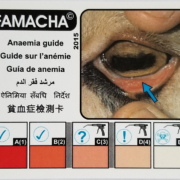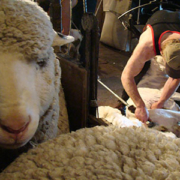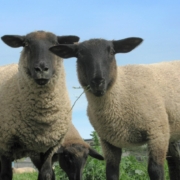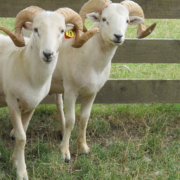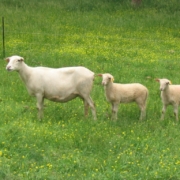Harmful Algal Blooms in Farm Ponds: Risks to Humans, Livestock, and Pets
 Print This Post
Print This Post
By Tammy Barnes, NCAT Agricultural Specialist
Now, as we enter the hot, dry summer months, is the time to watch livestock water sources for quality. Water is the most important nutrient in the diet and is especially critical during summer. When the weather heats up, all algae, filamentous and planktonic, grow rapidly in response to environmental factors such as sunlight, water column temperature, water pH, and stagnation.
Most algal blooms are harmless and are often seen as foam, or mats of “pond scum” both on the surface and attached to the bottom. But blooming blue-green algae or cyanobacteria can turn toxic from June to September. Farm ponds and slow-moving creeks and streams that are enriched with fertilizer runoff and directly deposited manure are the perfect place to find cyanobacteria thriving. Blooms are more common when there is a long dry period after a rain event. These harmful algal blooms (HABs) often look like paint on the water surface and sometimes there is an associated “off odor.” There may be dead fish in the pond area where the cyanobacteria are present.
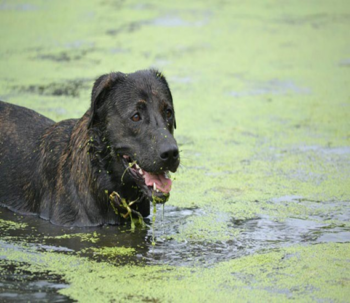
Photo: Tammy Barnes, NCAT
There are thousands of species of cyanobacteria with about 100 that produce toxins that can affect animals and humans. These bacteria produce neurotoxins, liver toxins, and skin irritants. Diarrhea; vomiting; skin rashes; eye, nose, and throat irritation; headaches; and allergic reactions are symptoms of human exposure to HABs from recreation or ingesting affected water. Animals that drink contaminated water may suddenly die, show severe signs of weakness and staggering, tremors, slobbering, difficulty breathing or rapid respiration rates and photosensitivity (white areas on body easily become burned and peel). Cattle are very sensitive to these toxins and sometimes whole herds of cattle are found dead near the pond when there are high toxin concentrations. The only treatment is supportive care and medications to relieve symptoms.
So, what can you do to prevent blue-green algal poisoning in humans and animals? Here are some important steps.
Animals
- Always assume that a blue-green algal bloom is toxic. Testing is very expensive.
- Prevent access to stagnant, scum-covered ponds and provide an alternative water source.
- Wash animals’ legs and body if they have come into contact to prevent them from ingesting toxins when coat licking.
- Do not let livestock loiter in ponds because they contaminate it with manure.
- Monitor ponds often in the hot summer months.
Humans
- Do not disregard warnings that are posted by public health officials.
- Do not swim in water with scum or blooms. Avoid water sports like tubing or water-skiing near or over blooms.
- Do not use untreated water for drinking, cooking or cleaning food, or washing camp gear or cleaning/cooking of food. Boiling water will not remove toxins.
- If contact is made thoroughly wash skin and hair.
- Do not eat fish caught in an area of pond scum.
Preventing cyanobacteria poisoning starts with good pond maintenance. A good preventative measure is to exclude cattle from the pond and either pumping from the pond into a tank or providing an alternative water source. An alternative is to give them limited access on the windward side by installing a fenced pond access ramp. Creating buffers around the pond with grasses, trees, or shrubs will reduce nutrients (phosphorus fuels algal growth in fresh water) entering the pond. Treating ponds with algaecides such as copper sulfate is expensive and when the cyanobacteria die, all the toxins are released into the water. This is not recommended. Pond bubblers can help keep the water from getting stagnant, and barley balls can help capture and inhibit cyanobacteria growth.
Related ATTRA Resources:
Managing Phosphorus for Clean Water
Other Resources:
Late summer algae blooms may cause problems in farm ponds
Harmful Algal Blooms – Are My Cattle in Danger?
How to Protect Livestock from Harmful Algal Blooms (HABs).
Identification and Management of Blue-green Algae in Farm Ponds
Managing Algal Blooms and the Potential for Algal Toxins in Pond Water
This blog is produced by the National Center for Appropriate Technology through the ATTRA Sustainable Agriculture program, under a cooperative agreement with USDA Rural Development. ATTRA.NCAT.ORG.


